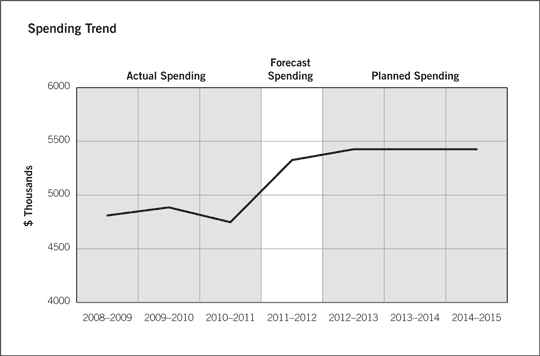Common menu bar links
Breadcrumb Trail
ARCHIVED - Public Service Staffing Tribunal - Report
 This page has been archived.
This page has been archived.
Archived Content
Information identified as archived on the Web is for reference, research or recordkeeping purposes. It has not been altered or updated after the date of archiving. Web pages that are archived on the Web are not subject to the Government of Canada Web Standards. As per the Communications Policy of the Government of Canada, you can request alternate formats on the "Contact Us" page.
Chairperson’s Message

I am pleased to submit the 2012–13 Report on Plans and Priorities for the Public Service Staffing Tribunal.
Since the Tribunal was formed in 2005 under the Public Service Employment Act, fair and impartial resolution of disputes has been its number one priority.
To this end, our focus remains on resolving complaints related to internal appointments and lay-offs in the federal public service through mediation, settlement conferences and hearings.
To address the challenge of the increasing number and complexity of complaints, the Tribunal will continue to build on its successes by implementing improved processes such as the settlement conference and the telephone/video mediation conference; and by developing more efficient business practices, such as the new pilot for an expedited hearing process.
These on-going improvements simplify the complaint resolution process, improve its timeliness and help ensure that parties to a complaint make good use of dispute resolution mechanisms available.
As we continue to provide the parties with opportunities to resolve complaints effectively and deliver decisions that are fair, consistent and well-reasoned, the Tribunal is fostering a greater understanding of the staffing regime and contributing to improving staffing and employee relations in the Public Service.
Guy Giguère
Chairperson and Chief Executive Officer
Section I: Organizational Overview
Raison d’être
Responsibilities
The Tribunal derives its mandate from the PSEA and is responsible for the impartial and timely consideration and disposition of complaints submitted under the Act with respect to internal appointment and lay-off processes in the Government of Canada.
By providing transparent, impartial and sound decision-making for complaints, as well as the support necessary to help parties resolve staffing disputes as informally as possible, the Tribunal is both accessible and responsive to its stakeholders – namely, deputy heads, human resources specialists, bargaining agents and public servants – and contributes to the effective management of human resources to the benefit of federal public service departments and agencies, managers, employees and Canadians at large.
Strategic Outcome and Program Activity Architecture (PAA)
To support its ongoing mandate and to continue delivering results for Canadians, the Tribunal has the PAA structure below. The Tribunal’s strategic outcome of fair and impartial resolution of disputes related to internal appointments and lay-offs in the Government of Canada will be supported by one program activity: adjudication and mediation of complaints filed under the PSEA, and internal services.
| Strategic Outcome | Fair and impartial resolution of disputes related to internal appointments and lay-offs in the Government of Canada |
|---|---|
| Program Activities | Adjudication and mediation of complaints filed under the Public Service Employment Act |
| Internal Services |
Organizational Priorities
In 2011–12 the Tribunal saw a significant increase in the number of files received and the complexity of the complaints that go to a hearing. The increasing number and complexity of complaints will continue to impact the Tribunal’s workload in 2012–13.
The Tribunal is focused on developing and strengthening processes which ensure greater efficiency and timely responses to high volume of requests for services. To continue in this role and take advantage of successes to date, the following priorities have been identified to help guide service delivery and the Tribunal’s decision-making.
| Priority | Type1 | Strategic Outcome |
|---|---|---|
| Efficient, simplified and well-documented processes | Ongoing | Fair and impartial resolution of disputes related to internal appointments and lay-offs in the Government of Canada. |
| Description | ||
|
Why is this a priority?
Plans for meeting the priority
|
||
| Priority | Type | Strategic Outcome |
|---|---|---|
| Timely issuance of reasons for decision | Ongoing | Fair and impartial resolution of disputes related to internal appointments and lay-offs in the Government of Canada. |
| Description | ||
|
Why is this a priority?
Plans for meeting the priority
|
||
| Priority | Type | Strategic Outcome |
|---|---|---|
| A workplace where people feel valued and know the importance of their contribution | Ongoing | Fair and impartial resolution of disputes related to internal appointments and lay-offs in the Government of Canada. |
| Description | ||
|
Why is this a priority?
Plans for meeting the priority
|
||
Risk Analysis
The Tribunal is faced with both internal and external risks. To minimize the impact of these risks, the Tribunal has put in place some ongoing strategies.
External
• Increased workload and change in nature of cases
As is the case with most administrative tribunals, the unpredictability of the Tribunal’s caseload represents a constant challenge. There was a sharp increase in the number of files received in the fiscal year 2011–12 compared with the previous years. Based on this trend we can expect an increase in 2012–13.
To mitigate this risk the Tribunal will plan, develop and implement new processes to deal with potential increases in the number and complexity of complaints.
• Key Reports and Decisions
The Tribunal will review the findings and recommendations of the December 2011 Report on the Review of the Public Service Modernization Act 2003 and develop and implement measures to improve Tribunal operations and services where appropriate.
For the first time, a Tribunal decision has been appealed to the Supreme Court of Canada. A decision on that case, which is expected in 2012, may have an impact on the Tribunal’s case law.
Internal
• Case Management System
The Tribunal will continue to collaborate with the Treasury Board Secretariat Chief Officer Information Branch, and quasi-judicial agencies on developing a possible enterprise-wide solution for a case management system.
However, it is crucial that the Tribunal implement a new case management system within the next 18 months, and therefore will continue to investigate alternative options.
• Human Resources – turnover of staff and members
As with many micro-agencies, the Tribunal is faced with challenges in turnover of employees and members, in part due to retirements and career development.
In order to mitigate this risk, the Tribunal will continue to recruit and ensure effective integration of new employees and members and offer learning opportunities.
The Tribunal has an integrated human resources and business plan and is committed to engaging employees and creating a workplace of choice. It will ensure that its succession strategy includes documenting processes and managing corporate information.
Planning Summary
Financial Resources ($ thousands)
| 2012-13 | 2013-14 | 2014-15 |
|---|---|---|
| 5,426 | 5,426 | 5,426 |
Human Resources (Full-Time Equivalent – FTE)
| 2012-13 | 2013-14 | 2014-15 |
|---|---|---|
| 38 | 38 | 38 |
| Performance Indicators | Targets |
|---|---|
| Percentage of complaints referred to judicial reviews on the grounds that the Tribunal failed to observe a principle of natural justice, procedural fairness or other procedure | 3% |
| Program Activity | Forecast Spending 2011-12 |
Planned Spending | Alignment to Government of Canada Outcomes | ||
|---|---|---|---|---|---|
| 2012-13 | 2013-14 | 2014-15 | |||
| Adjudication and mediation of complaints filed under the Public Service Employment Act | 3,885 | 3,838 | 3,838 | 3,838 | Government Affairs: a public service that reflects excellence and leadership. |
| Total Planned Spending | 3,838 | 3,838 | 3,838 | ||
| Program Activity | Forecast Spending 2011-12 |
Planned Spending | ||
|---|---|---|---|---|
| 2012-13 | 2013-14 | 2014-15 | ||
| Internal Services | 1,440 | 1,589 | 1,589 | 1,589 |
| Total Planned Spending | 1,589 | 1,589 | 1,589 | |
Expenditure Profile
In 2012–13, the Public Service Staffing Tribunal (PSST) plans to spend $5.4 million to meet the expected results of its program activity and contribute to its strategic outcome. In 2009–10, through Budget 2009, the PSST was provided with permanent funding and more recently, received approval from the Treasury Board of an adjustment to a previous funding transfer enabling it to more effectively fulfill its mandate requirements.
Departmental Spending Trend
The figure below illustrates the Tribunal’s spending trend from 2008–09 to 2014–15. For the 2008–09 to 2010–11 periods, the total spending includes all Parliamentary appropriation sources: Main Estimates, Supplementary Estimates, transfers from Treasury Board Votes and also includes carry forward adjustments. For the 2012–13 to 2014–15 periods, the
total spending corresponds to the planned spending.

Estimates by Vote
For information on our organizational appropriations, please see the 2012–13 Main Estimates publication at: www.tbs-sct.gc.ca/est-pre/20122013/me-bpd/info/info-eng.asp
